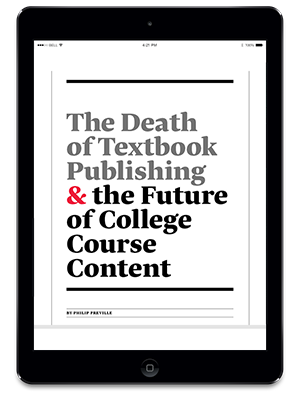The past 40 years will be seen as a time when college textbook companies ignited, expanded beyond expectation, and then began to die. And it’s all down to how people read.
Prices of college textbooks have been increasing since the late 1970s when textbook companies found color printing and illustrations were far more popular with students than black-and-white text. A 1986 study by Georgia State University found that while comprehension stayed the same, students “preferred” illustrations. And higher printing costs meant higher charges.
But this snowballed, and prices increased by 1,041 percent between 1977 and 2015. Nicole Allen, from the Scholarly Publishing and Academic Resources Coalition, told NBC that a lack of competition in a captive market was to blame (students have to buy the text).
Covering the Cost, a 2016 survey by the Student Public Interest Research Groups (PIRG) into textbook pricing, found the following:
- 80 percent of the market is controlled by five textbook companies (including Pearson and Wiley)
- Individual textbooks can easily cost $200, and sometimes up to $400
- 30 percent of students have had to resort to financial aid to buy textbooks.
Now, a second shift of media—towards digital, open-access and low-cost content—is starting to disrupt textbook companies.
Subscribe to Top Hat’s weekly blog recap
Get the best posts of the week delivered to your inbox:
At least two of the main players are suffering. The Financial Times reports that Pearson is dealing with a “long-term structural decline” due to a softening market, sinking college registration, and the rise of digital. Pearson’s latest revenue forecast is down by 7 percent.
Meanwhile, Wiley’s print textbook sales are down by 31 percent compared with last year and their higher education revenue shrank 14 percent last quarter to $73.8 million.
The Wiley Online Library and Pearson’s CourseConnect try to answer the shift to digital, but these kinds of products are not covering the revenue shortfall from falling print sales—a similar situation as in journalism.
Digital is a marketplace with an easier bar for entry, and traditional textbook companies are finding it harder to compete with free, or low-cost options of equal quality. Widespread adoption of these kinds of open textbooks, according to PIRG, could save students collectively up to $1 billion a year.
OpenStax, which has been providing peer-reviewed higher education materials since 2012, is partnered with 11 universities including the University of Arizona as a course provider. Top Hat’s Catalog offers these titles and many interactive ones, too.

Try Our Tool
Find out how much money your students could save if you ditch print textbooks.
Our Textbook Affordability Calculator can help.
There’s clearly an international fightback starting. In the U.S., the University of Arkansas is offering stipends of $3,000 to faculty members who incorporate open access materials in their courses, and $7,500 for those who create them. At Western Sydney University, students starting in 2017 will be given free digital textbooks.
And when the cost is borne directly by higher ed institutions, such as with academic journals, even more direct action is happening.
This month in Germany, the DEAL Project of 60 universities announced that it was pulling out of all subscriptions from scientific publisher Elsevier. According to Techdirt, the colleges hope that canceling subscriptions en masse will persuade the giant, which made a 30.5 percent profit margin in 2015, to change its business model.
To get around this, Göttingen University suggests that researchers use interlibrary loans if there is a copy of a journal they need: an idea quite close to the existing rental market for pricey textbooks. And if campus staff and students are adopting the same tactics, a revolution is clearly on the cards.

Students’ cellphones and digital devices aren’t bad for education. Learn how they can save your class money on textbooks—and increase classroom engagement.
Fill in your details below to get our white paper now.


